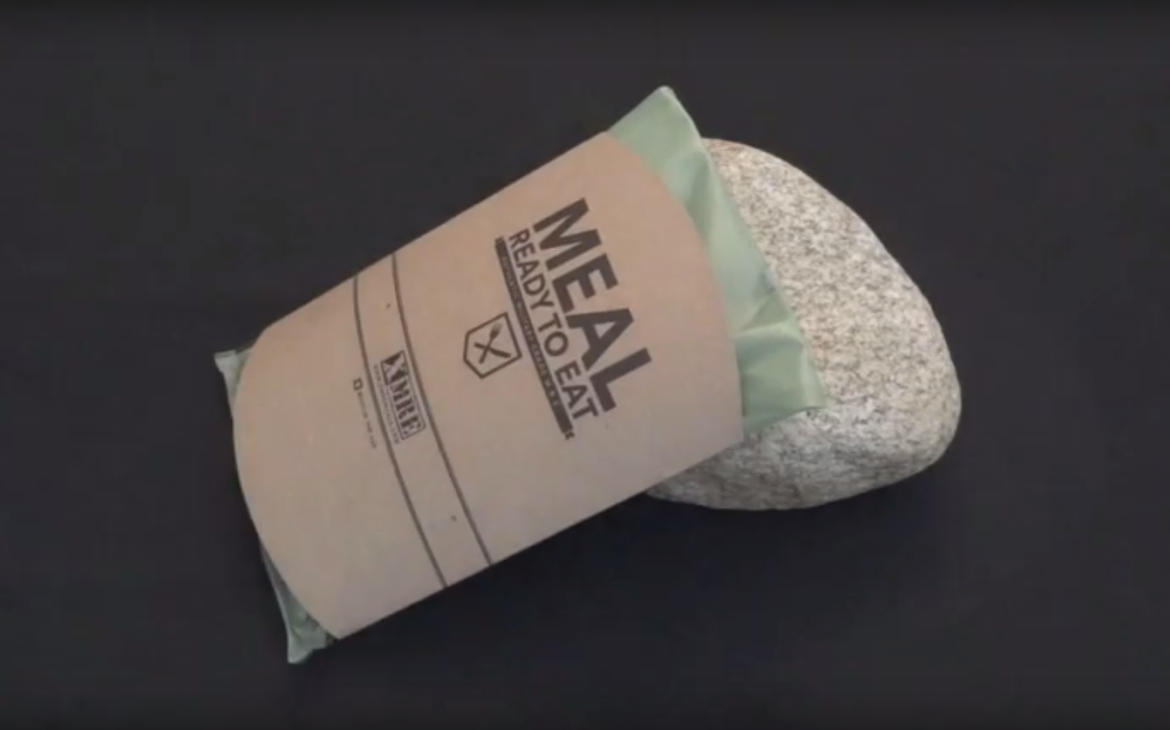An FRH, or Flameless Ration Heater is a self-contained, exothermic chemical heater that is water activated and used to heat ready-made food. It is usually included with MREs (ready-to-eat meals) and specifications require the heater to raise the temperature of 8 ounces or 226.8-gram entrée by 56 °C or 100 °F in about twelve minutes with no visible flame. It can be used to heat food in pouches or tins and can take two single meals at the same time. It is compact, lightweight, easy to transport, and the chemical pad composed of magnesium, iron, and salt is easily disposable.
How Does a Flameless Ration Heater Work?
The heater generates heat via an electron-transfer process that is known as an oxidation-reduction reaction. Magnesium in a fine powder form is alloyed with a small amount of table salt and iron that causes a reaction when a small amount of water is added. As the reaction proceeds the water quickly reaches a boiling point in the heater, heating the food that it comes into contact with.
Magnesium metal is oxidized by water according to a chemical reaction which is analogous to iron-oxygen causing iron to rust. This process proceeds at a very slow rate that cannot generate any usable heat. When metallic iron particles and table salt is mixed with magnesium particles, it accelerates the reaction. Iron and magnesium elements, when suspended in an electrolyte (salt water), form a galvanic cell, just like a battery, that is capable of generating electricity. When the salt in a Flameless Ration Heater is dissolved by water, it forms an electrolyte that turns each magnesium and iron particle into a tiny battery. When these iron and magnesium particles come into contact with each other, thousands of tiny short-circuit batteries are formed which quickly burn out, generating heat. This process of heat production, called ‘Supercorroding Galvanic Cells’ by the patent holders of the product, is what makes these heaters to effective.
Benefits and Features
These heating units will make ready to eat meals piping hot in minutes. No cooking is required as the temperature of the food is brought to at least 100° F without flame which makes them particularly useful where fires are prohibited or where it could be dangerous – for example for children who are on a camping trip. They are useful to keep in storage in case of a natural disaster or when prolonged power outages occur. The U.S. Military and NASA make use of Flameless Ration Heaters for MREs as it provides a simple method for quickly providing meals with no risk of fire or explosion.
How to Use MRE Flameless Ration Heaters
Simply tear off the top of the heating bag, place the MRE entrée or a water tight container of food into the bag. Follow the instruction and pour a small amount (a couple of tablespoons) of water in to the bag until it reaches the water-line near the bottom of the bag. Hold for a little while to allow the chemicals to be dissolved, then close the bag by folding over the top. Prop the bag up against something sturdy like a rock on a slight incline and wait for 10 – 15 minutes. The food will be piping hot and ready to eat.
FRHs are useful to keep in the car alongside bottled water and an emergency ration pack. They can come in handy in the case of a vehicle break-down in a remote area, or when sever weather situations cause you to get stranded. If you are a serious camper, hiker or traveler, this is a must-have item. It requires a tiny amount of water which makes it easy to take on trips, and it takes up very little space.
Safety precautions
Be warned that the food can become very hot depending on the ingredients so be careful when handling it while removing from the heating bag. It can heat MREs or any tightly sealed home-cooked meals that contain moisture. Rice and pasta recipes with sauce work particularly well as does tinned food or pouches.
To prevent a premature reaction from occurring while in transit or storage the heating bag must be carefully packed to protect it from tears or punctures. They must also be kept where there is no water or excessive moisture in the air. If the MRE Flameless Ration Heater is exposed to moist air, it may become coated with a thin layer of magnesium hydroxide that is insoluble and could interfere with the chemical reactions needed to generate heat.
Heating pads that become wet can release hydrogen gas which could cause a serious risk of fire or explosion as the magnesium becomes burning hot and ignites. It is vitally important to follow all instruction on the packaging and heed all warnings printed on the product.

Leave a comment
This site is protected by hCaptcha and the hCaptcha Privacy Policy and Terms of Service apply.